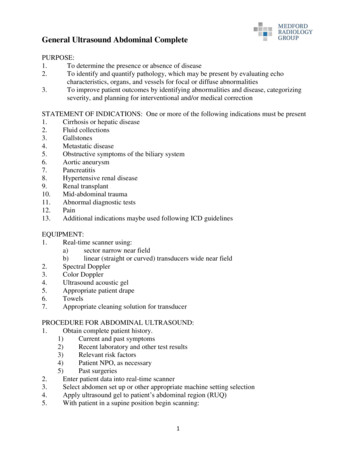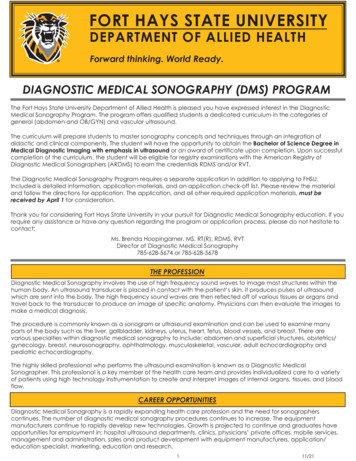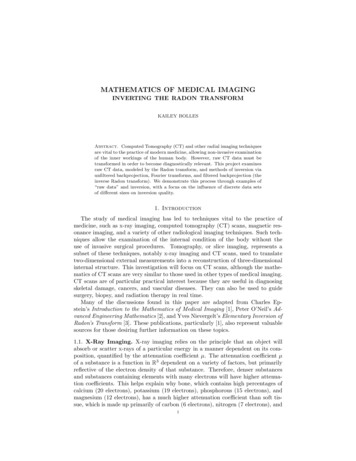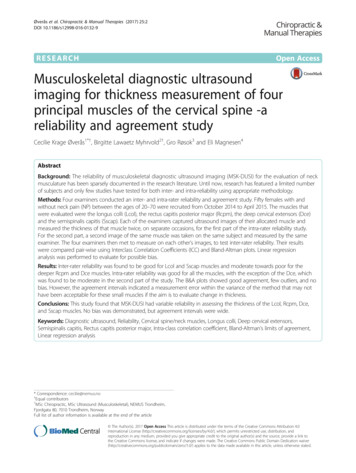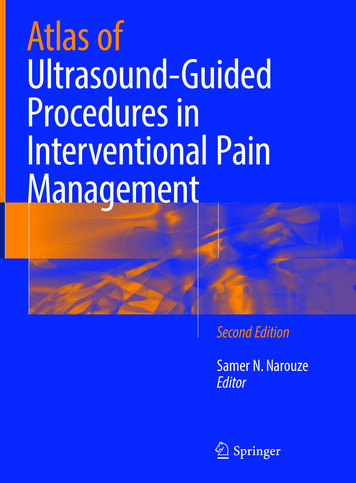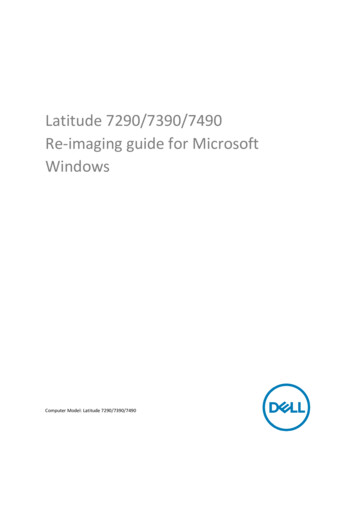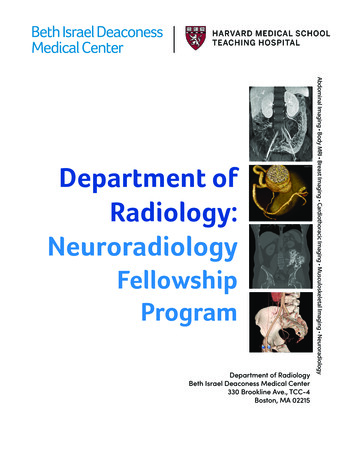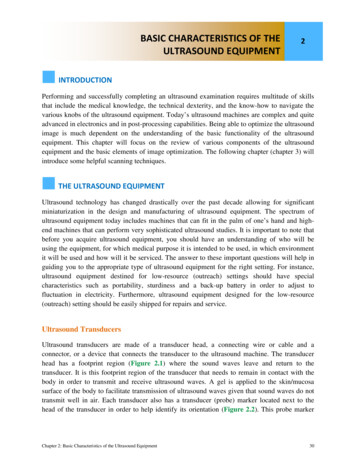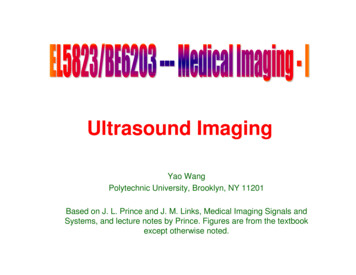
Transcription
Ultrasound ImagingYao WangPolytechnic University, Brooklyn, NY 11201Based on J. L. Prince and J. M. Links, Medical Imaging Signals andSystems, and lecture notes by Prince. Figures are from the textbookexcept otherwise noted.
Lecture Outline Ultrasound imaging overviewUltrasound imaging system schematicDerivation of the pulse-echo equationDifferent ultrasound imaging modesSteering and focusing of phased arraysDoppler ImagingClinical applicationsEL5823 Ultrasound ImagingYao Wang, Polytechnic U., Brooklyn2
Ultrasound Imaging Measure the reflectivity of tissue to sound wavesCan also measure velocity of moving objects, e.g. blood flow (Dopplerimaging)No radiation exposure, completely non-invasive and safeFastInexpensiveLow resolutionMedical applications: imaging fetus, heart, and many othersEL5823 Ultrasound ImagingYao Wang, Polytechnic U., Brooklyn3
Schematic of an Ultrasound ImagingSystemEL5823 Ultrasound ImagingYao Wang, Polytechnic U., Brooklyn4
Functions of transducer Used both as Transmitter And Receiver Transmission mode: converts an oscillating voltage intomechanical vibrations, which causes a series of pressurewaves into the body Receiving mode: converts backscattered pressurewaves into electrical signalsEL5823 Ultrasound ImagingYao Wang, Polytechnic U., Brooklyn5
Single Crystal Transducer (Probe)(damping)EL5823 Ultrasound ImagingYao Wang, Polytechnic U., Brooklyn6
Pulse Echo Imaging Transducer is excited for a short period, generating anarrowband short pulse Detects backscattered wave (echo) generated by objects Repeat the above process, with the interval between twoinput pulses greater than the time for the receiver toreceive the echo from the deepest object (2 d max/c)EL5823 Ultrasound ImagingYao Wang, Polytechnic U., Brooklyn7
Typical Transmit PulseEL5823 Ultrasound ImagingYao Wang, Polytechnic U., Brooklyn8
Spectrum of the Transmit PulseProduct of a decaying envelopand a sinusoidal functionne (t ) cos(2πf 0t )ne (t ) cos 2πf 0t 1ne (t ) e j 2πf 0t e j 2πf 0t2()1N e ( f ) * [δ ( f f 0 ) δ ( f f 0 )]21[N e ( f f 0 ) N e ( f f 0 ) ]2Narrow band (around f0) pulseEL5823 Ultrasound ImagingYao Wang, Polytechnic U., Brooklyn9
What is the Received Signal? What is the received signal (backscattered signal) at thetransducer ? How is it related to the reflectivity in the probed medium?EL5823 Ultrasound ImagingYao Wang, Polytechnic U., Brooklyn10
Each point (x0,y0)produces apressure wavep(x,y,z,t;x0,y0)The scattered signalsover all (x0’,y0’) leadsto a voltage signalr(x,y,z;t), all due to asingle scatter at (x,y,z)A scatter at (x,y,z)reflects p(x,y,z;t);generatingp s(x0’,y0’;t;x,y,z)( x0' , y0' ,0)Wavep(x,y,z;t) issuperposition ofabove wavesover all pointson thetransducer faceVibrating in z directionEL5823 Ultrasound ImagingYao Wang, Polytechnic U., Brooklyn11
Complex Signal Representation We will represent the input signal as the Real part of acomplex signal to simplify derivationEL5823 Ultrasound ImagingYao Wang, Polytechnic U., Brooklyn12
Derivation of the Pulse Echo Equationz 1p( x, y, z , t ; x0 , y0 ) 2 n(t c r0 ) Pressure wave produced by point (x0,y0)r0(each point acts as a dipole rather than a monopole,222()()r x x y y z2000Signal is strongest in the direction orthogonal to thedipole) Total pressure at (x,y,z) is superposition of above due to all x0,y0 in the transducerfacezp( x, y, z , t ) s ( x0 , y0 )20rn(t c 1r0 )dx0 dy0s( x, y ) 1, if ( x, y ) in face; 0, otherwise Reflected signal due to scatterer at (x,y,z) with reflectiveity R(x,y,z) is a sphericalwave, with signal at transducer position x0’,y0’p s ( x0' , y0' , t ) R ( x, y, z ) 1r0'The generated electrical signal (voltage) depends on reflected signal at all points inzthe transducer''''r ( x, y, z , t ) K s( x0 ' , y0 ' ) KR ( x, y, z ) s ( x0 ' , y0 ' ) p ( x, y, z; t c 1r0' )r0'ps ( x 0 , y 0 ; t )dx 0 dy 0 ' 'z z 1 1 's(x,y)n(tcrcr)dxdy 000000 dx 0 dy 0r '02 r02 The total response for scatters at all possible (x,y,z)EL5823 Ultrasound Imagingz/r0’ due to dipole patternYao Wang, Polytechnic U., Brooklynr (t ) r ( x, y, z , y )dxdydz13
Plane Wave Approximationn(t ) ne (t )e j φ e j 2πf 0tn(t c 1r0 c 1r '0 ) ne (t c 1r0 c 1r '0 )e jφ e j 2πf 0 (t c 1r0 c 1r '0 )Approximation : r0 r '0 zne (t c 1r0 c 1r '0 ) ne (t 2c 1 z )Also using t 2 z/c in the exponente j 2πf 0 (t c 1r0 c 1r '0 ) e j 2πf 0c 1( 2 z r0 r '0 ) e jk ( z r0 ) e jk ( z r '0 )This approximation enables us to separate integration over x0,y0 andthat over x0’,y0’EL5823 Ultrasound ImagingYao Wang, Polytechnic U., Brooklyn14
Field Pattern and Pulse-Echo Equation(depends only on transducer face, not pulse)Basic pulse-echosignal equation From all scatters, and considering attenuation in material with µa:EL5823 Ultrasound ImagingYao Wang, Polytechnic U., Brooklyn15
Paraxial ApproximationThis is the same result that we would have got had we assumed that allpoints on the transducer act as spherical wave generators and receiversEL5823 Ultrasound ImagingYao Wang, Polytechnic U., Brooklyn16
Fresnel & Fraunhofer ApproximationNear field boundary (NFB)Fresnel region Fraunhofer region(far field, beam spreading)Vibrating flat plateGeometricapproximation:Wave is confined ina cylinderEL5823 Ultrasound ImagingD24λYao Wang, Polytechnic U., Brooklyn17
Fresnel and Fraunhofer Approximations(valid in Fresnel region)(further approximation, in far field)S(u,v): FT of s(x,y)EL5823 Ultrasound ImagingYao Wang, Polytechnic U., Brooklyn18
General Pulse-Echo EquationEL5823 Ultrasound ImagingYao Wang, Polytechnic U., Brooklyn19
Time Gain Compensation2(ct)g (t ) EL5823 Ultrasound Imaginge µ a ctYao Wang, Polytechnic U., Brooklyn20
Envelope Detection In A-mode of ultrasound imaging, the envelope of r c(t)is detected and used as the output signal e c(t) envelope of r c(t)Since n(t) and q(x,y,z) depend only on the source, e c(t) is affected bythe reflectivity R(x,y,z) in the imaged body, or e c(t) R(0,0,z ct/2)EL5823 Ultrasound ImagingYao Wang, Polytechnic U., Brooklyn21
Transducer Motion and Range EquationPrevious result assumes the transducer is located at (0,0,0). When thetransducer is at arbitrary (x0,y0), q(x,y,z) is changed to q(x-x0,y-y0,z)at (x0,y0,ct/2)EL5823 Ultrasound ImagingYao Wang, Polytechnic U., Brooklyn22
Geometric Approximation (FresnelRegion)With geometric approximation, we assumeq ( x, y, z ) zq ( x, y, z ) s ( x, y )ThenRˆ ( x, y, z ) K R( x, y, z )e j 2 kz * * * h( x, y, z ) z h ( x, y , z ) s 2 ( x , y ) ne c/2 s ( x, y ) s ( x, y ) If we ignore the e {jkz} term, Received signal (envelope) at (x,y,t) isR(x,y,z) (z tc/2) convolved with h h(x,y,z) can be thought of as a blurring function. Its support regiondefines the resolution cell of the imaging system With geometric approximation, the resolution cell has the samedimension as the transducer face in (x,y) plane, and the extend in zdirection cT/2, if T is the length of the transmit pulse.EL5823 Ultrasound ImagingYao Wang, Polytechnic U., Brooklyn23
Fraunhofer ApproximationWith Fraunhofer approximation and assuming ( x 2 y 2 ) 2 z 0 (correct when z x, y, i.e., near axis)22x yq ( x, y, z ) zq ( x, y, z ) S ( , )e jk ( x y )λz λ z2z S(x y, )λz λzfor z D 2 / λRˆ ( x, y, z ) K R( x, y, z )e j 2 kz * * * h( x, y, z )2 x y z h( x, y, z ) S , ne zzc/2λλ S (u , v) : Fourier transform of s ( x, y ) sinc function for square plateNote that the spatial extend of the resolution cell now increases with Z.That means the lateral resolution decreases with Z. The lateralextension is also not finite (sinc function)EL5823 Ultrasound ImagingYao Wang, Polytechnic U., Brooklyn24
Speckle Noise Recall with either geometric or Fraunhofer approximationRˆ ( x, y, z ) K R( x, y, z )e j 2 kz * * * h( x, y, z ) e {j2kz}*R(x,y,z) modifies R(x,y,z) Can be thought of as modulating R(x,y,z) in z with frequency k/\pi e {j2kz} has period \pi/k \lambda/2, so each sound period(\lamda) includes 2 cycles of the modulating wave. An ultra soundpulse typically includes several \lambda So there are multiple cycles in z-direction in the resolution cellEL5823 Ultrasound ImagingYao Wang, Polytechnic U., Brooklyn25
Example Consider the case when a transducer is pointing downthe z-axis, on which 2 scatters are located at z1 and z2,both in the Fraunhofer field. The envelope of theexcitation pulse is rectangular with duration T. Sketchthe envelope of the received signal. Go through in class Note: results depend on relative distances between z1and z2EL5823 Ultrasound ImagingYao Wang, Polytechnic U., Brooklyn26
Ultrasound Imaging Modes A-mode M-mode B-modeEL5823 Ultrasound ImagingYao Wang, Polytechnic U., Brooklyn27
A-Mode Display Oldest, simplest type Display of the envelope of pulse-echoes vs. time, depth d ct/2– Measure the reflectivity at different depth below the transducer positionThe horizontal axis can be interpreted as z, with z t c/2EL5823 Ultrasound ImagingYao Wang, Polytechnic U., Brooklyn28
Application of A-Mode Applications: ophthalmology (eye length, tumors),localization of brain midline, liver cirrhosis, myocardiuminfarction Frequencies:2-5 MHz for abdominal, cardiac, brain;5-15 MHz for ophthalmology, pediatrics, peripheral bloodvessels Used in ophthalmology to determine the relativedistances between different regions of the eye and canbe used to detect corneal detachment– High freq is used to produce very high axial resolution– Attenuation due to high freq is not a problem as the desiredimaging depth is smallEL5823 Ultrasound ImagingYao Wang, Polytechnic U., Brooklyn29
M-Mode Display Display the A-mode signal corresponding to repeated input pulses inseparate column of a 2D image, for a fixed transducer position– Motion of an object point along the transducer axis (z) is revealed by a brighttrace moving up and down across the image– Often used to image motion of the heart valves, in conjunction with the ECGEL5823 Ultrasound ImagingYao Wang, Polytechnic U., Brooklyn30
B-Mode Display Move the transducer in x-direction while its beam is aimed down the z-axis, firing anew pulse after each movementReceived signal in each x is displayed in a columnUnlike M-mode, different columns corresponding to different lateral position (x)Directly obtain reflectivity distribution of a slice! (blurred though!)EL5823 Ultrasound ImagingYao Wang, Polytechnic U., Brooklyn31
Application of B-Mode Can be used to study both stationary and movingstructures High frame rate is needed to study motion (more later) Directly obtain reflectivity distribution of a slice! (blurredthough!)– No tomographic measurement and reconstruction is necessary!EL5823 Ultrasound ImagingYao Wang, Polytechnic U., Brooklyn32
3-D Imaging By mechanically or manually scanning a phased array transducer in adirection perpendicular to the place of each B-mode scanCan also electronically steering the beams to image different slicesFrom [Webb2003]EL5823 Ultrasound ImagingYao Wang, Polytechnic U., Brooklyn33
Depth of Penetration Recall that the amplitude of the wave attenuates in distance followingA( z ) A0 e 1 A( z )µ a lnzA0 µa zAttenuation coefficientAz1α 20 log10 e µ a 20 log10zA0– \alpha is linearly increasing with f: alpha a f System penetration is defined at the depth when 20 log 10 A0/Az L (dB)(often 80dB)zLCombining above1Laf zL z afdp 2 2af– z is the round trip disiance, depth of penetration is half– Lower penetration at higher frequency Rule of thumb– L 80dB, a 1, d p 40/f (Mhz) cmEL5823 Ultrasound ImagingYao Wang, Polytechnic U., Brooklyn34
Pulse Repetition Time The time needed to receive an echo at the maximum distance 2d p/c Pulse repetition time T R 2d p/c Pulse repetition rate f R 1/T R B-mode image frame rate– N pulses are required in each frame– Total time N T R– Frame rate F 1/NT R acf/NL Typical numbers– 10-100 frames/sec Frame rate should be commensurate with object motion For faster moving objects,– reducing field of view and consequently N– Increasing frequency (at the cost of reduced depth of penetration)EL5823 Ultrasound ImagingYao Wang, Polytechnic U., Brooklyn35
B-mode Scanner Types To reduce scanning time for each frame, a B-mode scanner usesmultiple transducersEL5823 Ultrasound ImagingYao Wang, Polytechnic U., Brooklyn36
Phased Arrays Phased array:– Much smaller transducer elements than in linear array– Use electronic steering/focusing to vary transmit and receive beamdirectionsEL5823 Ultrasound ImagingYao Wang, Polytechnic U., Brooklyn37
Transmit SteeringEL5823 Ultrasound ImagingYao Wang, Polytechnic U., Brooklyn38
Delays for Steering Extra distance that T0travels than T1: d d sin θ For the wave from T1to arrive at a point atthe same time as T0,T1 should be delayedbyT d / c d sin θ / c If T0 fires at t 0, Tifires att i iT id sin θ / cEL5823 Ultrasound ImagingYao Wang, Polytechnic U., Brooklyn39
Transmit FocusingEL5823 Ultrasound ImagingYao Wang, Polytechnic U., Brooklyn40
Delays for FocusingEL5823 Ultrasound ImagingYao Wang, Polytechnic U., Brooklyn41
Receive BeamformingTi should receive T sec later than T i 1EL5823 Ultrasound ImagingYao Wang, Polytechnic U., Brooklyn42
Receive Dynamic FocusingT0 fires at direction \theta, and all Ti’s receive after a certain delay,so that they are all receiving signal from the same point at aparticular timeEL5823 Ultrasound ImagingYao Wang, Polytechnic U., Brooklyn43
Delay for Dynamic Focusing First consider a stationary scatterer at (x,z) Time for a wave to travel from T0 to the scatterer and then to Ti isti x 2 z 2 (id x) 2 z 2 / c Time difference between arrival time at T0 and at Ti t i t 0 t i x 2 z 2 (id x) 2 z 2 /c T0 fires at t 0, direction \theta. After time t,T0 reaches x(t) ct\sin\theta, z(t) ct \cos \theta (possible scatterer) Desired time delay is a function of t:EL5823 Ultrasound ImagingYao Wang, Polytechnic U., Brooklyn44
Doppler Imaging Principles– Velocity vs. frequency shift (Doppler Freq) Used for blood flow velocity measurement– Stenosis or narrowing of the arteries causes blood flow velocitychange– Children at risk of stroke have cerebral blood velocities 3-4 timesof normal Imaging methods:– Continuous wave (CW) Doppler measurement Demodulation Time correlation– Pulse mode Doppler measurementEL5823 Ultrasound ImagingYao Wang, Polytechnic U., Brooklyn45
Doppler Effect: Moving source Doppler effect: change in frequency of sound due to the relativemotion of the source and receiver Case 1: moving source (scatterer), stationary receiver (transducer)– Source moving away, wavelength longer, lower freq– Source moving closer, wavelength shorter, higher freq.source (freq f o ) moving with speed v opposite the wave direction :one period T 1/f ocrest in wave moves a distance of cT c/f o without source motionsource moves a distance of vT v/f oWith source motion, crest moves a distance of cT vT .The above can be thought of as the equivalent wavelength λT cT vTEquivalent temporal frequency isfT cλT cfoc vGeneral case :source moving in a direction θ :(angle between source- receiver vector and source motion vector)cfOc v cos θDoppler frequency :fT v cos θv cos θfO fOc v cos θcθ π / 2 : source moving away from receiver, f D 0f D fT fO θ π / 2 : source moving towards receiver, f D 0EL5823 Ultrasound ImagingYao Wang, Polytechnic U., Brooklyn46
Doppler Effect: Moving Receiver Case 2: stationary source (transducer), moving receiver (target)––––Transducer transmitting a wave at freq fs, wavelength c/fsObject is a moving receiver with speed v, with angle θTarget moving away (θ π/2), sound moves slowerTarget moving closer (θ π/2), sound moves fasterc v cos θfScDoppler frequency :fO v cos θfScθ π / 2 : source moving away from receiver, f D 0f D fO f S θ π / 2 : source moving towards receiver, f D 0EL5823 Ultrasound ImagingYao Wang, Polytechnic U., Brooklyn47
Doppler Effect for Transducer Transducer:–––––Transmit wave at freq fs to objectObject moves with velocity v at angle θObject receives a wave with freq fo (c vcosq)/c fsThe object (scatterer) reflects this wave (acting as a moving source)Transducer receives this wave with freqcc v cos θfT fO fSc v cos θc v cos θ– Doppler freq 2v cos θ2v cos θf D fT f S fS fSc v cos θcDopper-shift velocimeter: as long as θ not eq 90 0, can recover objectspeed from doppler freq.Doppler imaging: display fD in space and time–EL5823 Ultrasound ImagingYao Wang, Polytechnic U., Brooklyn48
CW Doppler Measurement Separate transmitter and receiver Transducer at a fixed position, transmit and receive overa relatively long period of time– No depth information– Assumes a single moving object below the transducer Both transmitted and received signals can be consideredas a sinusoidal signal with freq. f s and f T respectively Instrumentation:– Use AM modulation to deduce the frequency shift f D– Use time-domain correlationEL5823 Ultrasound ImagingYao Wang, Polytechnic U., Brooklyn49
Instrumentation for demodulation basedmethodFrequencyCounterSpectrumAnalyzerFrom Graber: lecture notes for BMI F05EL5823 Ultrasound ImagingYao Wang, Polytechnic U., Brooklyn50
Homodyne DemodulationFrom [Webb2003]EL5823 Ultrasound ImagingYao Wang, Polytechnic U., Brooklyn51
CW Doppler Measurement ExampleFrom: Graber Lecture notes for BMS F05EL5823 Ultrasound ImagingYao Wang, Polytechnic U., Brooklyn52
Time Correlation See Figure 3.26 in [Webb] Performing correlation of twosignals detected at twodifferent times Deducing the time shift \tau(correspondingly distancetraveled) that yields maximumcorrelation Determine the velocityEL5823 Ultrasound ImagingYao Wang, Polytechnic U., Brooklyn53
EL5823 Ultrasound ImagingYao Wang, Polytechnic U., Brooklyn54
Pulse Mode Doppler Measurement Use only one transducer– Transmits short pulses and receives backscattered signals anumber of times Can measure Doppler shifts in a specific depth Schematic– See Figure 3.24 in [Webb]EL5823 Ultrasound ImagingYao Wang, Polytechnic U., Brooklyn55
EL5823 Ultrasound ImagingYao Wang, Polytechnic U., Brooklyn56
Duplex Imaging Combines real-time B-scan with US Doppler flowmetryB-Scan: linear or sectorDoppler: C.W. or pulsed (fc 2-5 MHz)Duplex Mode:– Interlaced B-scan and color encoded Doppler images limits acquisition rate to 2 kHz (freezing of B-scan imagepossible)– Variation of depth window (delay) allows 2D mapping (4-18pulses per volume)From: Graber Lecture notes for BMS F05EL5823 Ultrasound ImagingYao Wang, Polytechnic U., Brooklyn57
Duplex Imaging ExampleFrom: Graber Lecture notes for BMS F05EL5823 Ultrasound ImagingYao Wang, Polytechnic U., Brooklyn58
Clinical Applications Ultrasound is considered safe; instrument is lessexpensive and imaging is fast Clinical applications– Obstetrics and gynecology Widely used for fetus monitoring– Breast imaging– Musculoskeletal structure– Cardiac diseases Contrast agentsSee Handouts (Sec. 3.11, 3.12, 3.13 in [Webb])EL5823 Ultrasound ImagingYao Wang, Polytechnic U., Brooklyn59
Summary How transducer works– Properties of piezoelectric crystal, needs for damping and matchinglayer Pulse-Echo equation– Relation between excitation pulse n(t), transducer face s(x,y) andreceived signal r(t)– General equation and different approximation– Need for time gain compensation– Envelope of received signal after time gain compensation is an estimateof the reflectivity distribution in the z-direction below the transducer Blurring function correspond to different approximation Resolution cell depends on transducer face and excitation pulse Lateral resolution depends on z with Fraunhofer approximation– Beam width increases with z Different US Scanning mode– A-mode (reflectivity in z for fixed (x,y) position), M-mode (motion trace inz for fixed (x,y)), B-mode (reflectivity in one cross section)– 3D imaging– Doppler imagingEL5823 Ultrasound ImagingYao Wang, Polytechnic U., Brooklyn60
Summary (cnt’d) Phased Array Steering and Focusing– Time delay for transmit element for steering and focusing– Time delay for receive focusing and dynamic focusing Velocity measurement using Doppler imaging– CW vs. time gated Clinical applications of different US imaging modesEL5823 Ultrasound ImagingYao Wang, Polytechnic U., Brooklyn61
Reference Prince and Links, Medical Imaging Signals and Systems,Chap 11 and Sec. 10.5 A. Webb, Introduction to Biomedical Imaging, Chap. 3 Handouts from Webb: Sec. 3.10: Blood velocitymeasurements using ultrasound; 3.13: clinicalapplications of ultrasoundEL5823 Ultrasound ImagingYao Wang, Polytechnic U., Brooklyn62
Homework Reading:– Prince and Links, Medical Imaging Signals and Systems, Sec.10.5, Ch.11– Handouts: Webb Sec 3.10-3.13 Problems:––––––––P11.4 (note T should be T 2 \lambda/c)P11.6P11.7P11.8P11.9P11.14P10.12 (note f R should be (c v) f 0/c )P10.13EL5823 Ultrasound ImagingYao Wang, Polytechnic U., Brooklyn63
EL5823 Ultrasound Imaging Yao Wang, Polytechnic U., Brooklyn 29 Application of A-Mode Applications: ophthalmology (eye length, tumors), localization of brain midline, liver cirrhosis, myocardium infarction Frequencies: 2-5 MHz for abdominal, cardiac, brain; 5-15 MH

